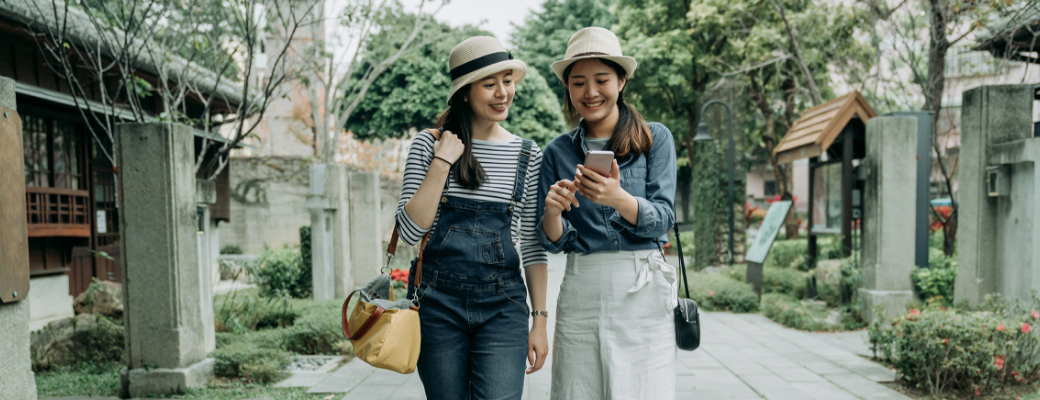
Digital Ticket
On sale: a set ticket including the Rapi:t , admission to the Tsutenkaku Observation Deck, and Nankai Soba!

Hike on your journey!
Hiking is an easy and enjoyable way to get in touch with nature. Although it does not require the rigorous equipment of mountaineering, there is still appropriate clothing for each season. This article explains what to wear for hiking in each season (spring, summer, fall, and winter). We will also introduce tips on how to dress fashionably.
Hiking makes you sweat even in cool spring and fall and cold winter. It can also suddenly become hot or cold depending on the weather and temperature changes. Therefore, keep in mind that the basic rule of hiking clothing is to dress in layers so that you can easily adjust the temperature.
Stretch fabrics that are easy to move around in and materials that absorb perspiration quickly and dry quickly are recommended.
In addition, the backpack or backpack you carry should be a lightweight, well-fitting outdoor brand to reduce fatigue while hiking.
Here is a look at what to wear for hiking in each season. First, let's look at what to wear for spring and fall hiking.
Spring and fall are seasons with large temperature differences. Even if the temperature is comfortable during the day, it is often chilly in the mornings and evenings. Be sure to pack warm clothing for spring and fall hiking.
A mountain parka is a useful piece of warm clothing. A mountain parka can be used as a windshield and can also be used as rainwear in the event of a little rain. Another advantage of mountain parkas is that they are lightweight and easy to carry.
A fleece or sweater can also be worn inside for protection against the cold. If you choose one that is easy to put on and take off, you can quickly adjust your body temperature when the temperature rises during the day.
Next, here are some tips on what to wear for summer hiking.
Summer is a hot season, but UV rays and insect protection are necessary, so it is best to avoid exposing bare skin as much as possible.
Adding climbing tights or leggings to half pants or wearing lightweight long pants will help protect against UV rays and insects. If you choose pants with functions such as moisture absorption, quick-drying, and contact cooling, you can spend your hot summer hiking in comfort.
And here are some tips on what to wear for winter hiking.
Warm clothing is essential for cold winter hiking. Take measures to protect yourself from the cold, such as wearing layers of underwear and innerwear with high heat retention properties.
Down jackets worn as outerwear are attractive for their high heat retention, but on the other hand, they can cause you to sweat when the temperature rises. Choose one that is lightweight and folds compactly so that you can quickly take it off when you feel hot and store it in a backpack or rucksack.
Another key to winter hiking attire is to utilize warm clothing such as neck warmers and gloves to keep the body cool from the neck and fingertips.
We have looked at what to wear for hiking in each season, but some people may want to enjoy dressing up as well. Hiking in your favorite clothes, paying attention to color and design, will make you feel more comfortable.
The key to a fashionable outfit is to match the colors of all items. For example, making two or more items the same color, such as a backpack and shoes, or innerwear and tights, will unify them and make them more fashionable.
Since many outdoor items are brightly colored, keeping the color in one or two places as a color accent will give a cozy impression.
Finally, here are some popular hiking trails along the Nankai Line.
Mt.Kongo
Mt. Kongo, one of Japan's two hundred most famous mountains, is located between Osaka and Nara and is known as the highest mountain in Osaka at 1,125 meters above sea level. There are several climbing routes, and the Fushimi Pass Route and Chihaya Main Route are recommended for beginners. The "Mt. Kongo Climbing Stamps" program is offered, whereby visitors can collect stamps for each summit and receive a special badge when the number of stamps exceeds a certain number.
Koya Pilgrimage (pilgrimage route in the Koya region of Honshu, Japan)
Koyasan, a sacred site of Japanese Buddhism, was opened by Kobo Daishi at the beginning of the Heian period (794-1185). In fact, it has become a popular spot for mountain climbing, and there are many climbing routes that allow visitors to feel the long history of Koyasan.
Choishi-michi
The "Choishi-michi" leads from Kudoyama at the foot of Mt. Koya to the Konpon-Daitō of Kongobuji Temple, a 22-km trail that follows 180 guideposts.
Kuroko-michi
Kurokomichi, which leads from Hashimoto, an inn town at the foot of the mountain, to Koyasan, is an atmospheric mountain trail with fantastic stone steps covered in moss.
Kyo-Osaka-michi
From Kamuro Station, where the Koya-kaido Road from Kyoto, Osaka, and Sakai converge, the "Kyo-Osaka-michi" leads to Fudozakaguchi Nyonin-do Hall, following the ruins of an old posting station.
Mt.Iwawaki
Mt. Iwawaki, which has one of the richest nature trails in Osaka Prefecture. The autumn scenery is breathtaking as silver grass spreads its ears and turns the area golden. The "Diamond Rail," a 45-km nature trail that runs from Donzurubo in Kashiba City, Nara Prefecture, through Mt. Nijo, Mt. Yamato-Katsuragi, Mt. Kongo, and Mt. Iwawaki to Mt. Makio in Izumi City, Osaka Prefecture, is commonly known as the "Day Trail" and is popular with mountain climbing enthusiasts.
In this issue, we have explained the key points of hiking attire for each season: spring, summer, fall, and winter. You can enjoy hiking to the fullest throughout the year if you are aware of how to dress fashionably, while also focusing on functionality to suit the season and temperature. We encourage you to try out some of the popular hiking courses along the Nankai Line.

